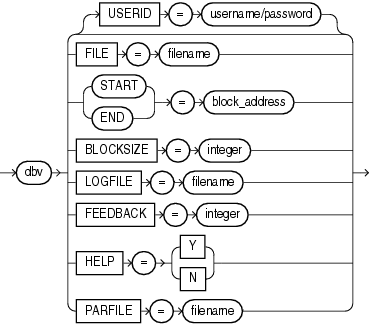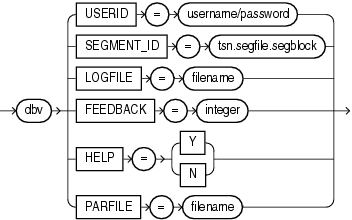| Oracle® Database Utilities 10g Release 2 (10.2) Part Number B14215-01 |
|
|
View PDF |
| Oracle® Database Utilities 10g Release 2 (10.2) Part Number B14215-01 |
|
|
View PDF |
DBVERIFY is an external command-line utility that performs a physical data structure integrity check. It can be used on offline or online databases, as well on backup files. You use DBVERIFY primarily when you need to ensure that a backup database (or datafile) is valid before it is restored, or as a diagnostic aid when you have encountered data corruption problems.
Because DBVERIFY can be run against an offline database, integrity checks are significantly faster.
DBVERIFY checks are limited to cache-managed blocks (that is, data blocks). Because DBVERIFY is only for use with datafiles, it will not work against control files or redo logs.
There are two command-line interfaces to DBVERIFY. With the first interface, you specify disk blocks of a single datafile for checking. With the second interface, you specify a segment for checking. Both interfaces are started with the dbv command. The following sections provide descriptions of these interfaces:
In this mode, DBVERIFY scans one or more disk blocks of a single datafile and performs page checks.
|
Note: If the file you are verifying is an Automatic Storage Management (ASM) file, you must supply aUSERID. This is because DBVERIFY needs to connect to an Oracle instance to access ASM files. |
The syntax for DBVERIFY when you want to validate disk blocks of a single datafile is as follows:

Descriptions of the parameters are as follows:
| Parameter | Description |
|---|---|
USERID |
Specifies your username and password. This parameter is only necessary when the files being verified are ASM files. |
FILE |
The name of the database file to verify. |
START |
The starting block address to verify. Specify block addresses in Oracle blocks (as opposed to operating system blocks). If you do not specify START, DBVERIFY defaults to the first block in the file. |
END |
The ending block address to verify. If you do not specify END, DBVERIFY defaults to the last block in the file. |
BLOCKSIZE |
BLOCKSIZE is required only if the file to be verified does not have a block size of 2 KB. If the file does not have block size of 2 KB and you do not specify BLOCKSIZE, you will receive the error DBV-00103. |
LOGFILE |
Specifies the file to which logging information should be written. The default sends output to the terminal display. |
FEEDBACK |
Causes DBVERIFY to send a progress display to the terminal in the form of a single period (.) for n number of pages verified during the DBVERIFY run. If n = 0, there is no progress display. |
HELP |
Provides online help. |
PARFILE |
Specifies the name of the parameter file to use. You can store various values for DBVERIFY parameters in flat files. This enables you to customize parameter files to handle different types of datafiles and to perform specific types of integrity checks on datafiles. |
The following example shows a sample use of the command-line interface to this mode of DBVERIFY.
% dbv FILE=t_db1.dbf FEEDBACK=100
The following is a sample verification of the file t_db1.dbf.The feedback parameter has been given the value 100 to display one period (.) for every 100 pages processed. A portion of the resulting output is also shown.
% dbv FILE=t_db1.dbf FEEDBACK=100 . . . DBVERIFY - Verification starting : FILE = t_db1.dbf ................................................................................ DBVERIFY - Verification complete Total Pages Examined : 9216 Total Pages Processed (Data) : 2044 Total Pages Failing (Data) : 0 Total Pages Processed (Index): 733 Total Pages Failing (Index): 0 Total Pages Empty : 5686 Total Pages Marked Corrupt : 0 Total Pages Influx : 0
Notes:
Pages = Blocks
Total Pages Examined = number of blocks in the file
Total Pages Processed = number of blocks that were verified (formatted blocks)
Total Pages Failing (Data) = number of blocks that failed the data block checking routine
Total Pages Failing (Index) = number of blocks that failed the index block checking routine
Total Pages Marked Corrupt = number of blocks for which the cache header is invalid, thereby making it impossible for DBVERIFY to identify the block type
Total Pages Influx = number of blocks that are being read and written to at the same time. If the database is open when DBVERIFY is run, DBVERIFY reads blocks multiple times to get a consistent image. But because the database is open, there may be blocks that are being read and written to at the same time (INFLUX). DBVERIFY cannot get a consistent image of pages that are in flux.
In this mode, DBVERIFY enables you to specify a table segment or index segment for verification. It checks to make sure that a row chain pointer is within the segment being verified.
This mode requires that you specify a segment (data or index) to be validated. It also requires that you log on to the database with SYSDBA privileges, because information about the segment must be retrieved from the database.
During this mode, the segment is locked. If the specified segment is an index, the parent table is locked. Note that some indexes, such as IOTs, do not have parent tables.
The syntax for DBVERIFY when you want to validate a segment is as follows:

Descriptions of the parameters are as follows:
| Parameter | Description |
|---|---|
USERID |
Specifies your username and password. |
SEGMENT_ID |
Specifies the segment that you want to verify. It is composed of the tablespace ID number (tsn), segment header file number (segfile), and segment header block number (segblock). You can get this information from SYS_USER_SEGS. The relevant columns are TABLESPACE_ID, HEADER_FILE, and HEADER_BLOCK. You must have SYSDBA privileges to query SYS_USER_SEGS. |
LOGFILE |
Specifies the file to which logging information should be written. The default sends output to the terminal display. |
FEEDBACK |
Causes DBVERIFY to send a progress display to the terminal in the form of a single period (.) for n number of pages verified during the DBVERIFY run. If n = 0, there is no progress display. |
HELP |
Provides online help. |
PARFILE |
Specifies the name of the parameter file to use. You can store various values for DBVERIFY parameters in flat files. This enables you to customize parameter files to handle different types of datafiles and to perform specific types of integrity checks on datafiles. |
The following example shows a sample use of the command-line interface to this mode of DBVERIFY.
dbv USERID=username/password SEGMENT_ID=tsn.segfile.segblock
For example, you could enter the following (assuming user hr had SYSDBA privileges):
dbv USERID=hr/hr SEGMENT_ID=1.2.67
The output would look similar to the following:
DBVERIFY - Verification starting : SEGMENT_ID = 1.2.67 DBVERIFY - Verification complete Total Pages Examined : 8 Total Pages Processed (Data) : 0 Total Pages Failing (Data) : 0 Total Pages Processed (Index): 1 Total Pages Failing (Index): 0 Total Pages Processed (Other): 2 Total Pages Processed (Seg) : 1 Total Pages Failing (Seg) : 0 Total Pages Empty : 4 Total Pages Marked Corrupt : 0 Total Pages Influx : 0 Highest block SCN : 7358 (0.7358)